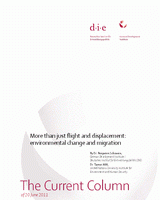More than just flight and displacement: environmental change and migration
Schraven, Benjamin / Tamer AfifiThe Current Column (2011)
Bonn: German Development Institute / Deutsches Institut für Entwicklungspolitik (DIE) (The current column of 20 June 2011)
Bonn, 20 June 2011. At the talks held in Bonn last week in preparation for the UN climate summit scheduled for Durban later this year no visible progress was made on the problem of climate- or environmentally induced migration, no commitment to finding practical solutions to a complex issue. Yet the subject of people forced to migrate by environmental factors – better not to use the term “refugee” in this context – has gained in importance in both the scientific and the political discourse. Estimates and forecasts of the scale of (future) forced migration due to environmental factors, for example, are a particular cause of controversy. In a recent article for the British newspaper The Guardian Achim Steiner, Executive Director of the United Nations Environment Programme (UNEP) and a former participant in the Postgraduate Training Programme run by the German Development Institute / Deutsches Institut für Entwicklungspolitik (DIE), referred to estimates by the International Displacement Monitoring Centre (IDMC), according to which at least 36 million people were forced to leave their homes by such environmental disasters as flooding in 2008. Steiner also makes it clear, however, that such estimates produce a highly simplistic picture of the context in which climate- or environmentally induced migration occurs. Environmental factors cannot in fact be viewed in isolation from other background factors: it is difficult to tell whether a person migrates for one reason rather than another.
Environmentally induced migration beyond flight and displacement
In other words, there are very few cases in which human beings emigrate solely for environmental reasons (drought, flooding, earthquakes), especially as many factors interact and processes occur gradually. Nor is it possible to make a clear distinction between voluntary migration and displacement. To date, the public debate has focused primarily on the question of how to protect people forced to leave their homes by the sudden onset of natural disasters, for example. There is a lively, though still predominantly academic, debate on whether a specific international regime needs to be established for such people, whether the Geneva Refugee Convention should be broadened or whether existing sets of international rules (on human rights, for instance) should be strengthened, adapted and linked. This debate is undoubtedly justified and important.
However, it excludes voluntary migration as a possible reaction to gradual environmental processes, as when irregular rainfall leads to losses of harvest. A number of studies (including the EACH-FOR project) point out that these voluntary forms of environmentally induced migration still occur far more frequently than forced migration due to environmental factors. Environment-induced forms of migration also include widespread seasonal migration, where one or more members of a household leave their home for a time during the non-growing season or periods of drought to work elsewhere.
Rural development has a key role to play
As the effects of climate change are likely to increase the numbers of people forced to migrate and those migrating voluntarily, the consequences of this environmentally induced migration need to be considered, and this not only at regional and national level but at international level, too. Although no one can estimate the probable scale, it can be assumed that increased environment-induced migration will exacerbate existing problems in the areas of the countries and global regions to which the migrants move: slum quarters in the cities will continue to grow; the working population of rural areas will decline; labour exploitation, trade in human beings and conflicts – possibly between states – will increase.
Can migratory pressure be eased? How can the negative implications be alleviated? It is currently unclear whether an effective international control body for (environmental) migration can be established. What can already be said, however, is that the development of rural areas and the reinforcement of small-scale agriculture have a key role to play, since small farmers form the vast majority of environmental migrants.
Positive examples in Africa
This is demonstrated by the small-scale irrigation farming to be found under extreme ecological conditions in Northern Ghana, where for more than ten years thousands of small farmers have been tapping shallow ground water on their own initiative to grow tomatoes in the dry season. The marketing opportunities are fundamentally good, the area having been brought closer to markets by the construction of roads in the 1990s. The revenue has not only improved family food security, but has also led to a significant decline in migration, previously of considerable seasonal importance for peasant households.
Rural development needs to be better and more energetically promoted by the international development community. In recent years there have certainly been positive signs: after the world food crisis of 2008/2009, for example, the German government pledged EUR 2.1 billion for rural development, agriculture and food security in the period 2010-2012. Nonetheless, the decades of neglect of (small-scale) agriculture in particular have not been overcome. The World Watch Institute, for instance, calculates that agriculture’s share of global development cooperation has shrunk by 75 per cent since 1980. Although the Northern Ghanaian example shows that small farmers do seize opportunities independently and without outside help, not all climate-induced risks, such as water shortages, can be combated with local resources. When adjustment measures are to be taken, small farmers must be supported with, say, appropriate extension services and the promotion of water storage technologies. The international community and especially the nation states cannot afford any further neglect if the food security of small farmers is not to be permanently endangered. For this may have serious consequences not only for farmers.

